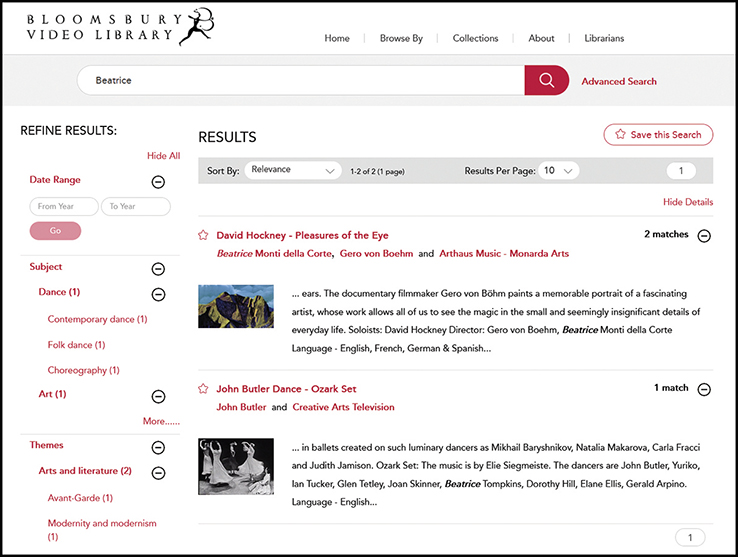Bloomsbury Video Library | eReview
Bloomsbury Video Library’s newly launched streaming-video platform hosts more than 2,000 film titles, which makes it a strong new contender for academic libraries’ streaming-video budgets.
Bloomsbury
CONTENT Bloomsbury Video Library’s newly launched streaming-video platform hosts more than 2,000 film titles in the arts and humanities, with a focus on visual and applied arts, film and media, dance, music, history and culture, and opera. Content includes documentaries, indie films and shorts, interviews, experimental films, instructional videos, and performances. Most of the content comes from Artfilms, an Australian independent film distributor acquired by Bloomsbury in 2021. Over 290 titles are exclusive to Bloomsbury Video Library worldwide.
Content is global and multilingual. Two thirds of the videos are in English, but many European, Asian, and African languages are also represented. Asian or African settings and/or creators are featured in 10 percent of the films, with substantial selections from China, Japan, Rwanda, and Singapore. Most of the videos date from the past 30 years, including 60 produced in or after 2020. Bloomsbury Video Library covers a diverse range of topics but so far lacks depth in most of them. Content will be added twice a year, so coverage will strengthen over time.
A highlight of Bloomsbury Video Library is its five opera collections, which consist of 88 recorded productions of 80 operas by more than 40 composers, spanning the Early and Baroque, Classical, Romantic, and Modern periods. The performances took place at Glyndebourne, the Royal Opera House, Teatro La Fenice, Teatro Real, and other prestigious opera houses.
USABILITY Patrons can search with precision across all the Bloomsbury Video Library collections to which their library subscribes (unsubscribed content is hidden by default). Patrons can limit searches by title, creator, abstract, category/keyword, identifier, and date range. They can also browse by subject, theme, language, era featured, era of creation, place featured, and creator’s place of origin. Categories are granular, and a video might be listed in multiple categories. For example, the subject of African studies contains subcategories such as demography and social movements.
Bloomsbury’s platform is visually appealing and straightforward for novice users to navigate. Each video has a digital object identifier (DOI) and basic metadata, including a description and credits for actors, designers, and producers. Pages and videos load quickly and display elegantly on both desktop and mobile devices. The video player enables patrons to adjust sound levels, switch to full-screen or picture-in-picture viewing modes and make and save clips (clipping does not appear to be available for all films). Video and sound quality is mostly excellent.
Many of the videos come with subtitles and auto-scrolling transcripts, which make the dialogue easy to follow and ensure a high degree of accessibility. The lack of closed captions for many other videos, including performances and talking-head documentaries, is disappointing. The good news, however, is that Bloomsbury has vowed to add transcripts to all videos by October 2023.
PRICING The Arts and Humanities Collection is available by subscription ($2,159 to $6,652) or perpetual access ($12,955 to $39,911). Smaller thematic subsets are available. The five opera collections are available by subscription ($247 to $5,919 per collection) or purchase ($1,485 to $35,517 per collection). Content updates are available for separate purchase or included in the subscription price. Pricing is based on size and type of institution, and consortia discounts may be available. An annual hosting fee of $100 covers all purchases of content on Bloomsbury Video Library.
VERDICT Featuring a medley of arts and humanities content on a user-friendly platform, Bloomsbury Video Library is a strong new contender for academic libraries’ streaming-video budgets.
RELATED
ALREADY A SUBSCRIBER? LOG IN
We are currently offering this content for free. Sign up now to activate your personal profile, where you can save articles for future viewing










Add Comment :-
Comment Policy:
Comment should not be empty !!!